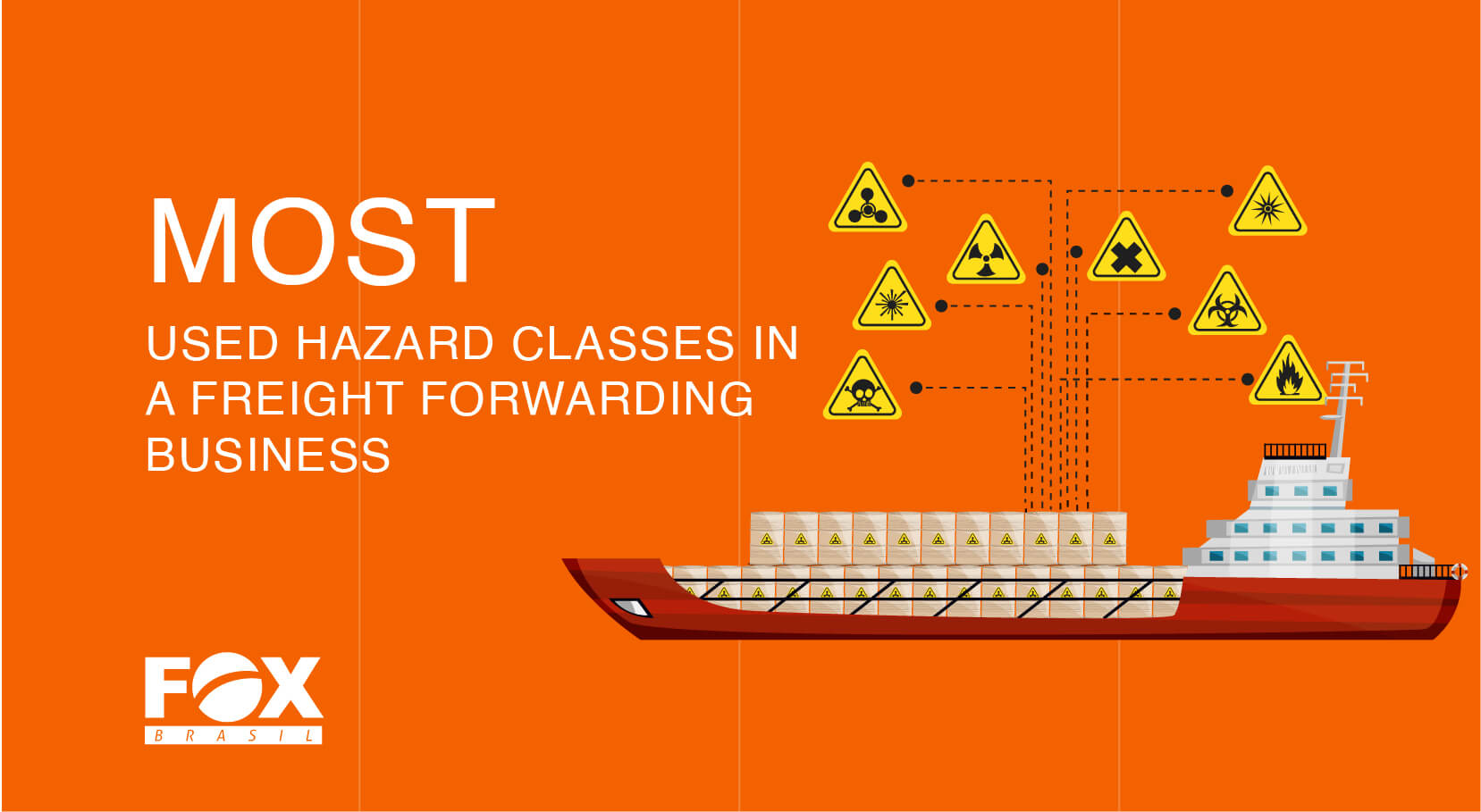Most used hazard classes in a freight forwarding business

Understand Logistics & Freight
In a previous post, we talked about some relevant strategies to deal with the transportation of dangerous goods, click here to check them out. Following up on this topic, as you probably know, in order to plan a dangerous good’s freight, it is essential to know in which hazard class this product belongs. This is the only way to be aware of the cargo’s particularities, the risks involved in its transportation, the right label to use for its freight and how to take every safety measure appropriately.
To make this process simpler for you, we have listed below the 9 most common categories of hazards goods and explained each of them in further detail. Let’s take a look?
Hazard classes: what are they?
Class 1: Explosives
This division covers explosive substances and articles. Some examples of goods that fit into hazard class 1 are ammunition, fireworks, airbag inflators, and fuse.
Class 1 sub-divisions:
- Division 1.1: Substances and articles which have a mass explosion hazard;
- Division 1.2: Substances and articles which have a projection hazard but not a mass explosion hazard;
- Division 1.3: Substances and articles which have a fire hazard and either a minor blast hazard or a minor projection hazard or both;
- Division 1.4: Substances and articles which present no significant hazard; only a small hazard in the event of ignition or initiation during transport with any effects largely confined to the package;
- Division 1.5: Very insensitive substances which have a mass explosion hazard;
- Division 1.6: Extremely insensitive articles which do not have a mass explosion hazard.
Class 2: Gases
This division covers compressed gases, liquefied gases, dissolved gases, refrigerated liquefied gases, mixtures of gases and aerosol dispensers/articles containing gas. Some examples of goods that fit into hazard class 2 are oxygen, natural gas, carbon dioxide, lighters, and aerosols.
Class 2 sub-divisions:
- Division 2.1: Flammable gases;
- Division 2.2: Non-flammable, non-toxic gases;
- Division 2.3: Toxic gases.
Class 3: Flammable Liquids
This division covers flammable liquids with flash points no more than 60-celsius degrees. Some examples of goods that fit into hazard class 3 are acetone, adhesives, paints, gasoline, perfume, ethanol, methanol and some pesticides with flammable solvents.
Class 4: Flammable Solids and Substances
This division covers flammable solids, substances liable to spontaneous combustion and substances which, in contact with water, emit flammable gases. Some examples of goods that fit into hazard class 4 are sulfur, matches, activated carbon, alkali metals, and some metal powders.
Class 4 sub-divisions:
- Division 4.1: Flammable solids;
- Division 4.2: Substances liable to spontaneous combustion;
- Division 4.3: Substances which, in contact with water, emit flammable gases.
Class 5: Oxidizing Substances and Organic Peroxides
This division covers oxidizing substances and organic peroxides. Some examples of goods that fit into hazard class 5 are hydrogen peroxide, potassium permanganate, sodium nitrite, ammonium nitrate fertilizers, and oxygen generators.
Class 5 sub-divisions:
- Division 5.1: Oxidizing substances
- Division 5.2: Organic peroxides
Class 6: Toxic and Infectious Substances
This division covers toxic substances and infectious substances. Some examples of goods that fit into hazard class 6 are cyanides, lead compounds, phenol, cresols, some pesticides, biological samples, and clinical wastes.
Class 6 sub-divisions:
- Division 6.1: Toxic substances
- Division 6.2: Infectious substances
Class 7: Radioactive Material
This division covers radioactive materials such as enriched uranium, radioactive ores, isotopes, and some medical equipment or parts. There is no sub-division in this category. However, there are different labels for radioactive materials which depend on the content and activity of such materials.
Class 8: Corrosive Substances
This division covers corrosive substances that may cause severe damage when in contact with living tissue such as skin or damage/destroy surrounding materials in case of leakage. Some examples of goods that fit into hazard class 8 are sulfuric acid, strong bases such as sodium hydroxide, batteries, and its fluids.
Class 9: Miscellaneous Dangerous Substances and Articles
This division covers substances and articles which during transport present a danger or hazard not covered by other 8 classes. This class encompasses, but is not limited to, environmentally hazardous substances, substances that are transported at elevated temperatures, miscellaneous articles and substances, genetically modified organisms and micro-organisms and (depending on the method of transport) magnetized materials and aviation regulated substances.
Some examples of goods that fit into hazard class 9 are marine pollutants such as zinc oxide, lithium-ion batteries, genetically modified organisms, airbag modules, and motor engines.
So, which hazard class do your products fit into?
Regardless of the type of product you need to transport, FOX Brasil is here to help! We are a freight forwarder with expertise and infrastructure to move any product safely and at the most competitive prices.
